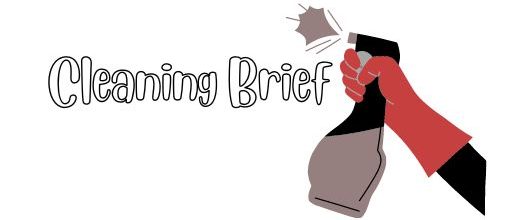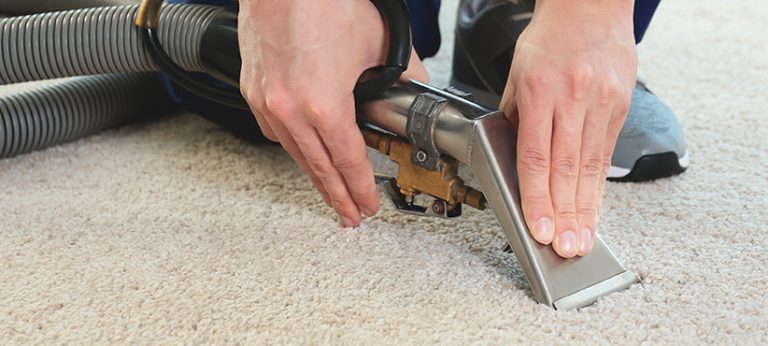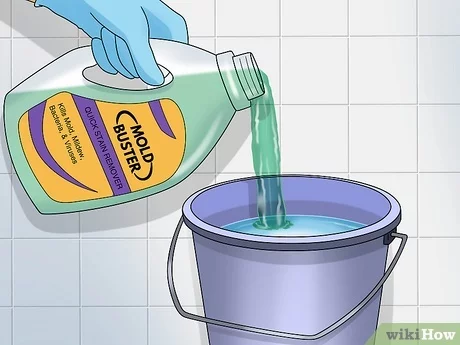How to Clean Mold off of Window Sills: Expert Tips for Spotless Windows
To clean mold off of window sills, mix equal parts vinegar and water in a spray bottle. Spray the solution onto the moldy areas, let it sit for a few minutes, then scrub with a brush or sponge.
Rinse the window sills thoroughly with water and dry them completely. Mold can be a common problem on window sills, especially in humid environments. Not only can it be unsightly, but it can also pose health risks if left untreated.
Cleaning mold off of window sills is important to maintain a clean and healthy living space. We will provide you with a simple and effective method to remove mold from your window sills. By following these steps, you can eliminate mold and prevent it from coming back, ensuring your windowsills stay clean and mold-free.

Credit: propertyproservice.ca
Understanding Mold On Window Sills
Mold growth on window sills is a common problem in many households. Not only can it be unsightly, but it can also pose health risks if left untreated. Understanding the causes of mold growth and the associated health risks is crucial for effective mold removal and prevention.
Causes Of Mold Growth
Mold thrives in damp and humid environments, making window sills an ideal breeding ground. The primary causes of mold growth on window sills include:
- Poor Ventilation: Insufficient airflow prevents moisture from escaping, trapping it on the window sills.
- Condensation: When warm indoor air meets the colder window glass, condensation occurs, providing moisture for mold growth.
- Leaking Windows: Water seepage through cracks or faulty seals can lead to moisture accumulation on the sills.
To effectively combat mold growth, it is necessary to identify and address the underlying causes. improving ventilation, controlling indoor humidity levels, and fixing any window leaks or drafts can help prevent future mold problems.
Health Risks Associated With Mold
Mold is not just an eyesore, it can also pose significant health risks to you and your family. Some common health issues associated with exposure to mold include:
- Allergies: Mold spores can trigger allergies, causing symptoms such as sneezing, congestion, watery eyes, and skin rashes.
- Asthma Attacks: Individuals with asthma are more susceptible to mold-related asthma attacks, which can be severe and life-threatening.
- Respiratory Problems: Prolonged mold exposure can lead to respiratory issues, including coughing, wheezing, and difficulty breathing.
- Infections: Certain types of molds, such as black mold, can produce mycotoxins that can cause infections, especially in individuals with weakened immune systems.
It is essential to address mold growth promptly to minimize these health risks. Regularly cleaning and maintaining your window sills can help create a healthier and safer home environment.
Preventive Measures For Mold Growth
Mold growth on window sills can be a persistent problem if not properly addressed. Luckily, there are preventive measures you can take to reduce the risk of mold growth and maintain a clean and healthy living environment.
Importance Of Proper Ventilation
Proper ventilation is crucial in preventing mold growth on window sills. Good airflow helps to keep moisture at bay, creating an unfavorable environment for mold to thrive.
Here’s what you can do to enhance ventilation:
- Open your windows regularly, especially after showering or cooking, to allow fresh air to circulate.
- Consider installing exhaust fans in areas with high humidity, such as bathrooms and kitchens, to remove excess moisture.
- Ensure that air vents are unobstructed and working efficiently to facilitate the airflow.
- Invest in a dehumidifier to control indoor humidity levels, especially in humid climates.
Regular Cleaning Routine
Maintaining a regular cleaning routine can go a long way in preventing mold growth on window sills. Regular cleaning helps to remove any accumulated moisture, dirt, and organic matter that might promote mold growth.
Follow these steps to establish an effective cleaning routine:
- Wipe down window sills with a dry cloth or sponge to remove any dust or debris.
- Using a mild detergent and warm water, scrub the window sills to eliminate dirt and grime.
- Dry the window sills thoroughly with a clean towel or allow them to air dry completely.
- Regularly inspect your window sills for any signs of mold growth and take immediate action if detected.
Remember: Prevention is key when it comes to mold growth on window sills. By implementing proper ventilation and establishing a regular cleaning routine, you can significantly reduce the risk of mold growth and maintain a clean and healthy living space.
Effective Cleaning Methods
When it comes to cleaning mold off of window sills, it’s essential to use effective methods that not only remove the mold but also prevent it from coming back. In this section, we will explore natural cleaning solutions and the use of commercial mold cleaners, providing you with the information you need to effectively clean mold from your window sills.
Natural Cleaning Solutions
If you prefer to use natural methods to clean mold off of your window sills, there are several effective options available. Vinegar is a potent natural cleaner, and when combined with water in a 1:1 ratio, it creates a solution that can effectively remove mold. Tea tree oil is another natural option that is known for its antifungal properties. By mixing a few drops of tea tree oil with water in a spray bottle, you can create a natural mold-fighting solution.
- Mix vinegar and water in a 1:1 ratio
- Create a solution with tea tree oil and water in a spray bottle
Using Commercial Mold Cleaners
If you prefer to use commercially available mold cleaners, there are several effective products on the market. Bleach is a powerful mold killer, but it should be used with caution and in a well-ventilated area. Hydrogen peroxide is another effective option that can be used to kill mold on window sills. Additionally, there are specific mold removal products that are designed to target and eliminate mold from various surfaces, including window sills.

Credit: simonswindows.com
Safety Precautions
Cleaning mold off window sills is an important task to ensure a healthy and safe living environment. However, it’s crucial to follow proper safety precautions to protect yourself from potential health risks associated with mold exposure. In this section, we will discuss the essential safety measures you should take before and during the cleaning process, including the use of protective gear and the proper disposal of contaminated materials.
Protective Gear For Cleaning
When starting the process of cleaning mold off window sills, wearing proper protective gear is essential to safeguard your health. Here are some recommended items to use:
- Gloves: Wear gloves made of latex or rubber to protect your hands from direct contact with mold and cleaning agents. Make sure the gloves fit well to ensure maximum protection.
- Mask or Respirator: Use an N-95 mask or a respirator specifically designed for mold cleanup. This will prevent you from inhaling potentially harmful mold spores during the cleaning process.
- Goggles: Protect your eyes by wearing goggles to prevent mold spores or cleaning agents from getting into your eyes.
- Full-Length Clothing: It’s recommended to wear long sleeves and pants to minimize skin exposure to mold and cleaning agents.
Proper Disposal Of Contaminated Materials
After cleaning the mold off your window sills, it’s important to dispose of the contaminated materials properly. Here are some guidelines to follow:
- Seal Materials: Place the mold-infested materials, such as rags or cleaning tools, in heavy-duty plastic bags. Seal the bags tightly to prevent any further mold spores from spreading.
- Separate Waste: Keep the mold-contaminated materials separate from regular household waste to prevent cross-contamination.
- Contact Local Authorities: Check with your local waste management authorities or health department to determine the appropriate way to dispose of mold-contaminated materials in your area.
- Follow Guidelines: Adhere to the disposal guidelines provided by your local authorities to ensure proper disposal and prevent any harm to the environment.
By following these safety precautions, you can effectively clean mold off your window sills while minimizing potential health risks. Remember, your safety should always be a top priority when dealing with mold or any other potentially hazardous substances.
Maintaining Clean Window Sills
When it comes to maintaining clean window sills, regular inspections and addressing water leaks are essential. Regularly inspecting your window sills allows you to identify and address mold growth early on, preventing it from spreading and causing further damage. Additionally, taking immediate action to address any water leaks or sources of moisture can help prevent future mold growth.
Regular Inspections
To maintain clean window sills, it’s important to conduct regular inspections. Here are some steps you can follow:
- Start by cleaning the window sills thoroughly. Use a soft cloth or sponge and a mild detergent to remove any dirt or debris. Wipe down the sills, paying extra attention to the corners and crevices where mold tends to grow.
- Once the window sills are clean, inspect them for any signs of mold growth. Look for black or green patches, discoloration, or a musty odor. If you spot any mold, take immediate action to remove it.
- If you notice any cracks or gaps in the window sills, seal them with caulk or silicone to prevent water from seeping in. This will help prevent mold growth in the future.
- Regularly check the surrounding area for any signs of water damage or leaks. Look for water stains on the walls or ceiling, drips or puddles near the windows, or warped or rotting wood. If you find any water-related issues, address them promptly to prevent mold growth.
- Consider using a dehumidifier in rooms with high humidity levels to reduce moisture in the air. This can help prevent mold growth not only on your window sills but also in other areas of your home.
Addressing Water Leaks
One of the most effective ways to maintain clean window sills is to address water leaks promptly. Here are some steps you can take:
- Check your windows regularly for any signs of leaks. Look for condensation on the glass, water droplets on the sills, or dampness around the frames.
- If you notice any leaks, determine the source. It could be a faulty window seal, damaged weatherstripping, or gaps around the window frame. Take the necessary steps to fix the problem.
- Seal any gaps or cracks around the window frame using caulk or weatherstripping. This will help prevent water from entering and causing mold growth on your window sills.
- If the window seal is damaged or worn out, consider replacing it to prevent further leaks and moisture intrusion.
- Ensure proper ventilation in the room to reduce humidity levels. Open windows or use exhaust fans in areas prone to higher moisture, such as bathrooms and kitchens.
By regularly inspecting your window sills and addressing water leaks promptly, you can maintain clean and mold-free window sills that not only enhance the aesthetics of your home but also contribute to a healthier living environment for you and your family.

Credit: simonswindows.com
Frequently Asked Questions For How To Clean Mold Off Of Window Sills
How To Remove Mold From Window Sills?
To clean mold off of window sills, mix equal parts of water and bleach, then scrub the affected area using a sponge or brush. Rinse with clean water and dry thoroughly. Alternatively, you can use a commercial mold removal product.
Remember to wear protective gloves and ensure proper ventilation during the cleaning process.
Why Do Window Sills Get Moldy?
Window sills can become moldy due to excess moisture, poor ventilation, or condensation. These factors create a damp environment, which is ideal for mold growth. To prevent mold on window sills, try to reduce moisture levels by using dehumidifiers, improving air circulation, and insulating windows against condensation.
Can Vinegar Remove Mold From Window Sills?
Yes, vinegar can effectively remove mold from window sills. Mix equal parts of vinegar and water, then spray or sponge the solution onto the moldy surface. Let it sit for a few hours, then scrub with a brush. Rinse with water and dry thoroughly.
Vinegar’s acidic properties help kill and inhibit mold growth.
Conclusion
Keeping window sills clean is crucial for maintaining a healthy home environment. By following the simple yet effective methods outlined in this post, you can easily remove mold from your window sills. Regular cleaning and proper ventilation will help prevent future mold growth, ensuring a clean and safe living space.






